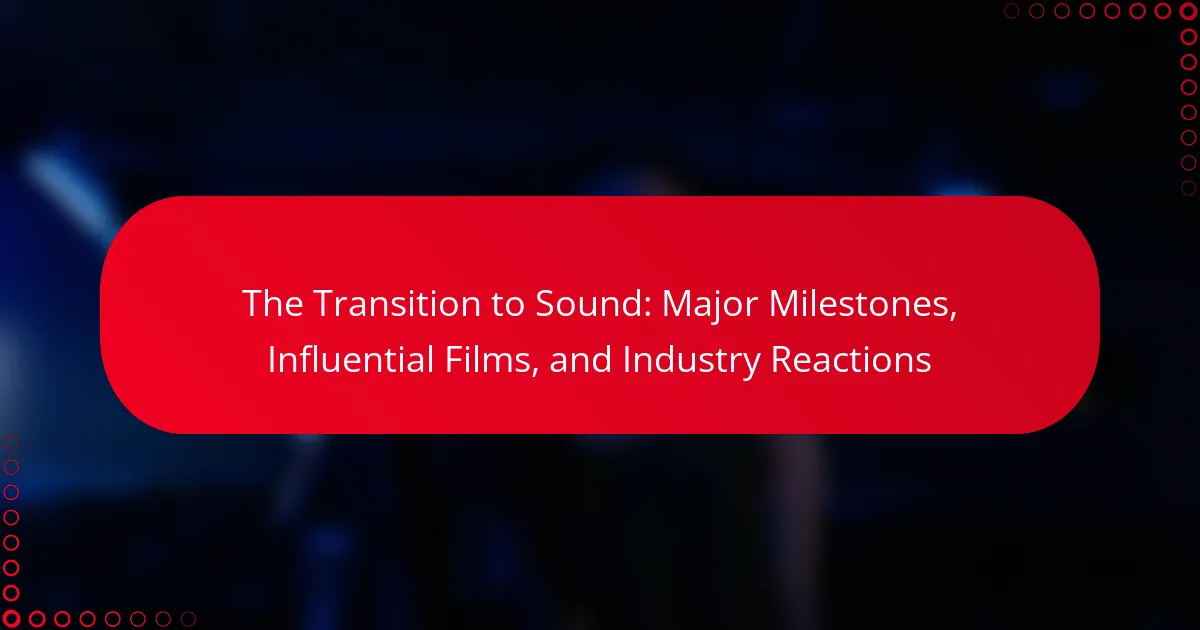The article explores the transition to sound in film, focusing on major milestones, influential films, and industry reactions. Key events include the release of “The Jazz Singer” in 1927, recognized as the first significant sound film, and “Lights of New York” in 1928, the first all-talking feature film. The introduction of synchronized sound technology, particularly through the Vitaphone system, revolutionized filmmaking and storytelling. Despite initial skepticism from filmmakers regarding sound’s impact on creativity, the industry ultimately embraced this advancement, leading to the decline of silent films and the rise of musicals by the mid-1930s.

What are the major milestones in the transition to sound in film?
The major milestones in the transition to sound in film include the introduction of synchronized sound in the late 1920s. The first successful sound film was “The Jazz Singer,” released in 1927. This film featured synchronized dialogue and musical numbers, revolutionizing the industry. In 1928, Warner Bros. released “The Singing Fool,” which further popularized sound films. The advent of the Vitaphone system allowed for better sound synchronization. By 1930, most major studios had adopted sound technology. The transition led to significant changes in film production and storytelling. By the mid-1930s, silent films had largely disappeared from theaters.
How did the introduction of sound technology change the film industry?
The introduction of sound technology revolutionized the film industry by enhancing storytelling and audience engagement. Silent films relied solely on visuals and intertitles. With sound, dialogue became an integral part of the narrative. This shift allowed for more complex characters and plots. The first synchronized sound feature, “The Jazz Singer,” released in 1927, marked a turning point. It showcased the potential of combining music and dialogue effectively. The success of sound films led to widespread adoption across studios. By the early 1930s, nearly all films incorporated sound technology. This transformation not only changed production techniques but also influenced audience expectations.
What were the key technological advancements that enabled sound in film?
The key technological advancements that enabled sound in film include the invention of the phonograph, the development of synchronized sound systems, and the introduction of optical soundtracks. The phonograph, invented by Thomas Edison in 1877, allowed for sound recording and playback. Synchronized sound systems, like the Vitaphone, were first used in the 1927 film “The Jazz Singer,” providing a breakthrough in sound synchronization with visuals. Optical soundtracks, developed in the late 1920s, allowed sound to be recorded directly onto film stock. These advancements collectively transformed the film industry, leading to the widespread adoption of sound in cinema.
What were the significant films that marked the transition to sound?
The significant films that marked the transition to sound include “The Jazz Singer,” released in 1927. This film is widely regarded as the first synchronized sound feature film. It featured Al Jolson and included musical numbers alongside spoken dialogue. “The Jazz Singer” revolutionized the film industry and led to the widespread adoption of sound in cinema. Another important film is “Lights of New York,” released in 1928, which was the first all-talking feature film. These films demonstrated the potential of sound in storytelling and transformed audience expectations.
Why was the silent film era significant before the transition to sound?
The silent film era was significant for its foundational role in developing cinematic storytelling. It established visual storytelling techniques that conveyed emotions and narratives without dialogue. Filmmakers used expressive acting, intertitles, and innovative camera work to engage audiences. Iconic silent films like “The Birth of a Nation” and “The Cabinet of Dr. Caligari” showcased artistic creativity and technical advancements. The era also fostered the global spread of cinema, with stars like Charlie Chaplin and Buster Keaton gaining international fame. This period laid the groundwork for the transition to sound by demonstrating the potential of film as an art form. The silent film era’s innovations influenced the future of filmmaking and paved the way for sound integration in cinema.
What were the defining characteristics of silent films?
Silent films were characterized by the absence of synchronized sound and dialogue. They relied heavily on visual storytelling and expressive acting. Intertitles were used to convey dialogue and narrative elements. Music was often played live during screenings to enhance the emotional experience. The performances featured exaggerated gestures to communicate emotions effectively. Cinematic techniques, such as title cards and visual metaphors, were employed to convey complex ideas. The genre often included physical comedy and slapstick humor, appealing to a broad audience. Iconic silent film stars, like Charlie Chaplin and Buster Keaton, became cultural icons during this era.
How did audiences respond to silent films compared to sound films?
Audiences initially responded positively to silent films, appreciating their visual storytelling. They enjoyed the expressive performances and the accompanying live music. However, with the introduction of sound films, audience reactions shifted significantly. Many viewers found sound films more immersive and engaging. The dialogue and synchronized sound enhanced emotional connections to the characters. By 1929, over 90% of theaters in the U.S. had converted to sound films, indicating a strong preference. Silent films became less popular as audiences embraced the novelty of sound. The transition marked a pivotal change in film history, altering audience expectations and experiences.

What influential films contributed to the transition to sound?
The influential films that contributed to the transition to sound include “The Jazz Singer,” “Lights of New York,” and “The Singing Fool.” “The Jazz Singer,” released in 1927, is widely recognized as the first significant sound film. It featured synchronized dialogue and songs, marking a pivotal moment in cinematic history. “Lights of New York,” released in 1928, was the first all-talking feature film. It showcased the potential of sound in storytelling. “The Singing Fool,” also released in 1928, built on the success of “The Jazz Singer” and further popularized sound in film. These films played critical roles in demonstrating the commercial viability and artistic possibilities of sound in cinema.
Which films are considered pioneers in sound technology?
The films considered pioneers in sound technology include “The Jazz Singer,” “The Singing Fool,” and “Lights of New York.” “The Jazz Singer,” released in 1927, is the first feature-length film with synchronized dialogue. It marked a significant shift in the film industry towards sound. “The Singing Fool,” released in 1928, further showcased the potential of sound in films with its musical numbers. “Lights of New York,” also from 1928, was the first all-talking feature film. These films collectively demonstrate the technological advancements in sound that transformed cinema.
What innovations did these films introduce to sound design?
These films introduced several key innovations to sound design. They pioneered synchronized sound, allowing dialogue and sound effects to match the action on screen. This was a significant departure from silent films, where intertitles conveyed dialogue. Additionally, they utilized multi-track recording, enabling the layering of different sound elements. This technique improved audio quality and allowed for more complex soundscapes. The use of location sound recording also became prevalent, capturing natural sounds during filming. Furthermore, they explored the creative use of sound effects, enhancing the storytelling experience. These advancements laid the groundwork for modern sound design in cinema.
How did these films influence audience expectations of sound in cinema?
These films significantly influenced audience expectations of sound in cinema by introducing synchronized sound and innovative sound design. The 1927 film “The Jazz Singer” was the first feature-length film with synchronized dialogue, setting a new standard for sound quality. Audiences began to expect clear dialogue and immersive soundscapes in films following its release. The use of sound effects and musical scores became integral to storytelling, enhancing emotional engagement. Films like “Snow White and the Seven Dwarfs” in 1937 showcased advanced audio techniques, further raising expectations. As a result, audiences started to associate sound quality with overall film quality, demanding more sophisticated audio experiences. This shift led to the development of new sound technologies and practices in the industry.
What role did musical scores play in the transition to sound?
Musical scores played a crucial role in the transition to sound in film. They provided emotional depth and context to silent films, enhancing the storytelling experience. As sound technology advanced, scores became integral to synchronized sound films. They helped establish mood, character, and narrative flow in early talkies. Notable examples include the use of orchestral scores in films like “The Jazz Singer” (1927). This film is often credited as the first successful “talkie” and featured synchronized music and dialogue. The incorporation of musical scores helped audiences adapt to the new sound format. It bridged the gap between silent cinema and the era of sound, facilitating a smoother transition for viewers.
How did composers adapt to the new sound technology in films?
Composers adapted to new sound technology in films by integrating synchronized scores. They began to compose music that matched on-screen actions. This synchronization enhanced emotional impact. Composers also utilized advancements in recording technology. They experimented with sound layering and effects. These innovations created richer audio experiences. Additionally, they collaborated closely with directors and sound engineers. This teamwork ensured a cohesive audio-visual narrative. Historical examples include Max Steiner’s work on “King Kong” in 1933, which showcased these techniques effectively.
What impact did soundtracks have on the storytelling of films?
Soundtracks significantly enhance the storytelling of films. They provide emotional depth and context to scenes. Music can evoke specific feelings, guiding audience reactions. For instance, suspenseful scores build tension during critical moments. Conversely, uplifting melodies can create a sense of hope or joy. The use of leitmotifs helps identify characters or themes throughout the film. Historical examples include “Jaws,” where the iconic score signals danger. Additionally, soundtracks can influence audience memory and perception of a film. Overall, soundtracks play a crucial role in shaping narrative experiences.

How did the film industry react to the transition to sound?
The film industry initially reacted with skepticism to the transition to sound. Many filmmakers feared that sound would limit creativity and artistic expression. The first successful sound film, “The Jazz Singer,” released in 1927, demonstrated the potential of synchronized sound. This film’s success led to widespread adoption of sound technology in the industry. Studios quickly invested in new equipment and training for sound technicians. Actors had to adapt to new techniques, as many silent film stars struggled with vocal performance. The transition also led to the decline of silent films and the rise of musicals. Overall, the industry embraced sound as a revolutionary advancement in filmmaking.
What challenges did filmmakers face during the transition to sound?
Filmmakers faced significant technical and creative challenges during the transition to sound. They had to adapt to new sound recording equipment, which was bulky and limited mobility on set. The synchronization of sound with visuals was complex and often unreliable. Filmmakers also needed to rethink storytelling techniques, as dialogue became essential. This shift affected pacing and required new acting styles. Additionally, many actors were untrained in voice performance, leading to inconsistent delivery. The industry also grappled with financial implications, as sound equipment was expensive to acquire and maintain. These challenges marked a transformative period in filmmaking history.
How did the industry adapt to new sound recording techniques?
The industry adapted to new sound recording techniques by embracing synchronized sound technology. This shift began in the late 1920s with the introduction of the Vitaphone system. Studios invested in soundproof stages to accommodate recording needs. They also trained staff in sound engineering and production techniques. The transition led to the development of new genres, such as musicals. Audiences responded positively, increasing box office revenues. By 1930, most films included synchronized sound, demonstrating widespread industry acceptance. This adaptation marked a significant evolution in filmmaking practices.
What were the economic implications of transitioning to sound for studios?
The economic implications of transitioning to sound for studios were significant. Studios faced high initial costs for sound equipment and technology. This transition required substantial investment in new recording techniques and facilities. Many silent film actors and crew members became obsolete, leading to layoffs. Conversely, sound films attracted larger audiences, increasing box office revenues. The demand for sound films created new job opportunities in sound engineering and production. By the late 1920s, sound films dominated the market, reshaping the industry’s economic landscape. The transition ultimately led to the consolidation of studios, as larger companies absorbed smaller ones unable to adapt.
What were the audience reactions to the introduction of sound in films?
Audience reactions to the introduction of sound in films were largely positive and enthusiastic. Viewers were captivated by the novelty of synchronized audio. The first successful sound film, “The Jazz Singer,” released in 1927, showcased this innovation. Audiences were amazed by the ability to hear dialogue and music. Many found it enhanced the emotional experience of storytelling. However, some traditionalists resisted the change, preferring silent films. The transition marked a significant shift in cinematic experience. By the late 1920s, most audiences embraced sound as a standard feature in films. Overall, the introduction of sound transformed the film industry and audience expectations.
How did sound change the viewing experience for audiences?
Sound transformed the viewing experience for audiences by adding depth and emotional resonance to films. It allowed for dialogue, which made storytelling more engaging and relatable. Audiences could now hear characters express emotions directly. This shift enhanced the overall immersion in the narrative. The introduction of synchronized sound in films like “The Jazz Singer” in 1927 marked a pivotal moment. This film was the first to incorporate synchronized dialogue, significantly impacting audience reactions. The integration of sound also led to the development of new genres, like musicals, which attracted wider audiences. Additionally, sound design improved the atmosphere, making scenes more impactful and memorable. Overall, sound enriched the cinematic experience, making it more dynamic and multifaceted.
What lasting effects did the transition to sound have on film genres?
The transition to sound significantly transformed film genres by enhancing narrative depth and character development. With synchronized dialogue, filmmakers could convey emotions more effectively. This led to the rise of genres like musicals and talkies, which thrived on vocal performances. Additionally, sound allowed for more complex storytelling techniques, such as the use of sound effects and ambient noise. Genres such as horror and drama benefited from sound, creating tension and atmosphere. The incorporation of music became essential, influencing the structure of films. This transition also affected audience expectations, as viewers began to seek richer audio-visual experiences. Overall, the shift to sound redefined genre conventions and storytelling methods in cinema.
What lessons can be learned from the transition to sound in film?
The transition to sound in film teaches several important lessons. First, it highlights the significance of technological innovation in storytelling. The introduction of synchronized sound transformed the way narratives were conveyed. Second, it emphasizes the necessity of adaptability within the film industry. Many studios struggled to adjust to the new technology, leading to the decline of some silent film stars. Third, it showcases the impact of audience reception on industry practices. Films like “The Jazz Singer” demonstrated that audiences embraced sound, prompting a rapid shift in production methods. Lastly, it illustrates the importance of training and skill development. Filmmakers and actors needed to learn new techniques for sound performance. These lessons remain relevant as technology continues to evolve in the film industry.
How can current filmmakers apply insights from the transition to sound?
Current filmmakers can apply insights from the transition to sound by embracing innovative storytelling techniques. The shift to sound in cinema required filmmakers to rethink narrative structure and pacing. They focused on dialogue delivery, sound effects, and music to enhance the emotional impact of scenes. For instance, films like “The Jazz Singer” demonstrated the importance of synchronized sound in engaging audiences. Filmmakers today can incorporate these lessons by blending audio elements seamlessly with visuals. This approach can create a more immersive experience for viewers. Historical context shows that the transition to sound revolutionized the film industry, leading to new genres and styles. Understanding these changes can inspire contemporary filmmakers to experiment with sound in their projects.
What best practices emerged from the industry’s adaptation to sound technology?
Best practices from the industry’s adaptation to sound technology include synchronized sound recording and post-production techniques. These practices ensure that dialogue matches the visual elements, enhancing viewer experience. Sound mixing and editing have become crucial in creating immersive audio landscapes. Additionally, the use of sound design to evoke emotions has been widely adopted. Training for sound engineers has improved significantly to meet new technical demands. Industry standards for equipment and formats have evolved to ensure compatibility and quality. Collaboration between sound and visual teams has become essential for cohesive storytelling. These practices reflect a significant shift in filmmaking, driven by technological advancements in sound.
The main entity of the article is the transition to sound in film, highlighting its major milestones, influential films, and industry reactions. Key milestones include the introduction of synchronized sound in the late 1920s, with “The Jazz Singer” (1927) as the first successful sound film, followed by “The Singing Fool” and “Lights of New York.” The article discusses technological advancements that enabled this transition, how sound transformed storytelling and audience engagement, and the challenges filmmakers faced during this period. Additionally, it examines the economic implications for studios and the lasting effects on film genres and audience expectations.
